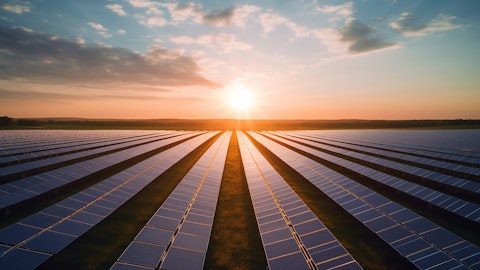Duke Energy Corporation (NYSE:DUK) Q4 2023 Earnings Call Transcript February 8, 2024
Duke Energy Corporation misses on earnings expectations. Reported EPS is $1.51 EPS, expectations were $1.54. DUK isn’t one of the 30 most popular stocks among hedge funds at the end of the third quarter (see the details here).
Operator: Hello all, and welcome to the Duke Energy Fourth Quarter and End Year 2023 Earnings Call. My name is Lydia, and I’ll be your operator today. [Operator Instructions] I’ll now hand you over to Abby Motsinger, Vice President of Investor Relations to begin.
Abby Motsinger: Thank you, Lydia, and good morning everyone. Welcome to Duke Energy’s Fourth Quarter 2023 Earnings Review and Business Update. Leading our call today is, Lynn Good, Chair, President and CEO; along with Brian Savoy, Executive Vice President and CFO. Today’s discussion will include the use of non-GAAP financial measures and forward-looking information. Actual results may differ from forward-looking statements, due to factors disclosed in today’s materials and in Duke Energy’s SEC filings. The appendix of today’s presentation includes supplemental information, along with a reconciliation of non-GAAP financial measures. With that, let me turn the call over to Lynn.
Lynn Good: Abby, thank you, and good morning everyone. Today, we announced 2023 adjusted earnings per share of $5.56, finishing the year within our guidance range and demonstrating once again our ability to exercise agility in managing our business and meeting our commitments. We also announced 2024 guidance of $5.85 to $6.10 with the midpoint of $5.98. This represents 6% growth from our original 2023 guidance and we extended our 5% to 7% EPS growth rate through 2028 off the midpoint of our 2024 range. We entered the year with significant momentum. 2024 marks a fundamental repositioning of our investment proposition. With the commercial renewable sale, we’ve transformed our business to become a fully regulated utility for the first time in decades.
Along with improved regulatory constructs, we’re poised to deliver on our simplified 100% regulated growth plan. Our Southeast and Midwest utilities operate in some of the fastest growing and most attractive jurisdictions across the US. We expect growth in our service territories to accelerate, as we move further into the energy transition driving substantial investment. We are now projecting $73 billion in CapEx over the next five years, an $8 billion increase versus our previous plan. Turning to slide 5, 2023 marked another year of outstanding accomplishments across our business, building on our compelling growth story as we move into ’24. As I mentioned, we completed our portfolio repositioning and delivered multiple constructive regulatory outcomes, while maintaining our commitment to safety and customers.
We executed five rate cases and I’m proud of the constructive results the team has delivered. We received orders approving $45 billion in historic and future rate base investments that will provide growth to customers for years to come. There was also a recognition of the rising cost of capital with improving ROEs and equity ratios. And in North Carolina, we implemented forward-looking multiyear rate plans for the first time ever. The performance-based regulations authorized by HB 951, provides certainty, predictability and value to customers and the company. This milestone was accomplished through years of work with policymaker’s, legislators and other stakeholders. Shifting to operations. Our teams performed well throughout the year, serving our customers in extreme weather conditions and restoring power following historic storms in Indiana and Florida.
Providing safe reliable power in all seasons and circumstances remains our mission. In fact, in 2023, Duke Energy Florida had its best reliability performance in more than a decade, largely due to our significant storm protection plan investments. These investments also aided restoration efforts in Hurricane Adalia, saving outage minutes and speeding return to service. In the Carolinas, our nuclear fleet continues to generate safe, reliable carbon-free power, achieving a capacity factor of 96%, the 25th year in a row above 90%. And underpinning all of this in a hallmark of our commitment to operational excellence, 2023 marked our best safety performance in company history, as measured by a total incident case rate of 0.31. Safety is a core value at Duke Energy and I’m proud of our employees’ commitment to event-free operations.
Finally, the Piedmont team continues to excel in customer service. For the second year in a row, J.D. Power ranked Piedmont number one in residential customer satisfaction for natural gas services in the Southeast. And our Carolinas electric utilities continue to achieve strong results as well, remaining in the top quartile. Moving to Slide 6, we start the year entering the next phase of our energy transition, a period of execution and record infrastructure build to meet the evolving energy needs of our customers and communities. We’re working with stakeholders to develop resource plans to support the phenomenal growth in our communities. In the Carolinas, demand is already outpacing the forecast used in our August resource plan filings and we filed supplemental portfolios in January.
We’re committed to meeting this growth with a diverse and increasingly clean energy mix that includes renewables, natural gas, next-generation nuclear and storage resources, as well as energy efficiency and demand response tools. We’re also taking steps to build new generation in North Carolina, we’ll file CPCNs for over two gigawatts of new natural gas generation in 2024. We’ll continue to advance annual solar procurements targeting one gigawatt per year. And in Indiana we’ll file CPCNs for new generation resources around midyear. These new facilities will add to our diverse mix of resources and are critical to meeting growing customer demand as we reliably exit coal by 2035. From a regulatory perspective, we’ve announced two rate cases in 2024 starting with DEC South Carolina in early January.
Since the last case in 2018, we’ve invested more than $1.5 billion to improve reliability and resiliency and meet the growing energy needs of our more than 650,000 customers. And in Florida, we notified the commission of our intent to file a rate case in April. Similar to our current multiyear rate plan, which runs through 2024, this filing will cover three years of investments beginning in 2025. Our plan will add over 1000 megawatts of new solar and include over $3 billion of grid investments to serve population growth, increased reliability and reduced storm-related outages. Finally since our last rate cases at Duke Energy Indiana and Piedmont North Carolina, we’ve continued to make investments to strengthen our system and we’re evaluating the timing of our next filings in these jurisdictions.
In closing, I’ll move to Slide 7, which depicts the transition of Duke Energy over the last many years to the premier regulated utility than it is today. The strategic and financial clarity provided by optimizing our portfolio over the last decade has simplified Duke Energy to a powerful, core regulated business operating in vibrant jurisdictions, growing through population migration and strong commercial and industrial economic development. Our growth potential is the highest it’s been in decades and is reflected in our $73 billion capital plan. This plan is driven by grid investments to transform the largest T&D system in the US and IRP-related generation investments to support our growing jurisdictions and fleet transition. An efficient recovery mechanisms allow us to translate these investments into customer and investor value.
In closing, we have positioned Duke for long-term value creation and our path forward is clear as we navigate the coming decade of record infrastructure build. This pivotal point in our history drives a differentiated low-risk, total return proposition going forward and I’m confident we will deliver. With that let me turn the call over to Brian.

Brian Savoy: Thanks, Lynn and good morning, everyone. Turning to Slide 8. 2023 marked a year of solid growth for our utilities. We achieved full year adjusted earnings per share of $5.56, which represents about 6% growth over 2022. For the year, we saw top line growth from constructive rate case outcomes, multiyear rate plans and rider growth across our jurisdictions. Additionally, we delivered on our cost and agility efforts, which offset record mild weather, lower volumes and higher interest expense. 2023 was a year full of significant headwinds and I’m proud of the team for executing on our agility plans including strong fourth quarter results to deliver on our financial commitments. Turning to Slide 9. We are introducing our 2024 guidance range of $5.85 to $6.10.
The midpoint of $5.98 represents more than 7% growth over 2023. Within electric, we expect normal weather and retail volume growth of roughly 2%. We also entered the year with updated rates for our North Carolina utilities including the benefit of the historic base case, as well as year one of the multiyear rate plans. Additionally, we have updated rates at Duke Energy Kentucky and expect updated rates for DEC South Carolina in August. We’ll see growth from year three of the Florida multiyear rate plan currently effect, and we will continue to see growth from grid investment riders in the Midwest and Florida. Partially offsetting these favorable drivers are higher interest expense as well as depreciation and property taxes on a growing asset base.
Our gas segment continues to deliver strong growth with investments across all jurisdictions related to integrity management and to serve a growing customer base. Finally, we expect the other segment to be impacted by higher interest expense and a higher effective tax rate. We ended 2023 with an ETR of 10%. Although, we continue to pursue a robust set of tax optimization strategies, we expect our 2024 ETR will increase to between 12% and 14%. Turning to retail electric volumes on slide 10. In 2023, we saw strong residential customer growth in all jurisdictions highlighted by the Carolinas and Florida at 2.1% and 2%, respectively. In fact over the course of 2023 we added 195,000 new customers, the largest customer increase in company history and a continuation of the trend we’ve seen over the past few years.
As a reminder, residential decoupling in North Carolina began in DEP in October and in DEC in January. This will reduce volatility and align growth with positive customer migration trends. We have also seen significant growth in economic development opportunities in our service territories as reflected in the recent supplemental Carolina’s resource plan filings. As we evaluate, which projects to include in our financial plan, we recognize that site selection processes are often very competitive. We generally only include the most mature and committed projects, focusing on those with letter agreements or in very late-stage development. This gives us upside potential should additional projects progress. Economic development opportunities in our service territories are diversified across many industries.
Semiconductors, EVs, batteries, pharmaceuticals, and data centers to name a few, which will provide growth from the projects themselves, as well as incremental growth from residential and supplier demand. These economic development and customer migration trends give us confidence in our 1.5% to 2% load growth expectation over the forecast period. Turning to slide 11 Duke’s proven track record of cost management will support our ability to execute an energy transition that is rooted in discipline and a commitment to safety for our employees and reliability and affordability for our customers. As I mentioned before, we delivered on our significant O&M and agility targets for 2023 in response to macroeconomic headwinds and unfavorable weather.
In 2024, we expect O&M to be largely flat to 2023, offsetting inflationary pressures with sustainable efficiencies and we will continue to target a flat cost structure over the five-year plan. Duke Energy is a leader in the industry when it comes to cost efficiency driven by our culture of continuous improvement. We consistently rank in the top quartile across a variety of O&M measures and our ability to manage our cost structure creates significant value for our customers and shareholders. Turning to slide 12. I’d like to provide an overview of our five-year $73 billion capital plan which has increased $8 billion over our previous plan. About half of the incremental capital is a result of rolling the plan forward a year to include 2028. The update reflects an early estimate of the supplemental Carolinas resource plan filed in January, as well as improved spend in the North Carolina multiyear rate plans.
Over time our capital plan has steadily increased as we move further into the clean energy transition, supporting a 7.2% earnings base CAGR through 2028. Grid investments represent 50% of our five-year capital plan and will improve the reliability and resiliency of our system. Significant generation spend ramps up in the latter part of the plan as we add more renewables and storage assets. Extend the life of our carbon-free nuclear fleet and make prudent investments in cleaner natural gas to better serve our growing customer base. Looking ahead, about 90% of the electric investments in our capital plan are eligible for efficient recovery mechanisms, which is critical to maintaining a strong balance sheet, mitigating regulatory lag and smoothing customer rate impacts.
Moving to slide 13. Our ability to execute our robust capital program is underpinned by a healthy balance sheet and we remain committed to our current credit ratings. With that in mind, we are introducing modest equity to fund the increase in capital plan we announced today. We expect to raise $500 million annually over the five-year plan starting in 2024, using at the market and dividend reinvestment programs. Turning to FFO to debt. We have provided a walk up, showing the path to achieve our 14% target by the end of ’24. Compared to 2023, we expect improvements from normal weather, rate case activity, the collection of remaining deferred fuel balances, the monetization of nuclear PTCs and equity issuances under the DRIP and ATM programs. These credit supportive drivers give us confidence in achieving 14% FFO to debt in 2024 and a minimum of 14% over the long term.
Let me talk a bit more about the nuclear PTC, an important element of the inflation Reduction Act that will provide substantial savings to our customers over time. As an operator of 11 low-cost nuclear units in the Carolinas, we expect to qualify for several hundred million dollars per year of nuclear PTCs beginning in ’24. We intend to monetize the credits in the transferability markets established by the IRA. In North Carolina, we worked with the public staff on a settlement regarding the treatment of nuclear PTCs that was approved in our DEC rate case order last year. We will flow back the benefits to customers over a four-year amortization period. This treatment allows customers to benefit from bill reductions over time and is supportive of the utility’s credit metrics.
Moving to slide 14, our robust capital plan, strong customer growth and constructive jurisdictions provide a compelling growth story. And our commitment to the dividend remains unchanged. We understand its importance to our shareholders and 2024 marks the 98th consecutive year of paying a quarterly cash dividend. We intend to keep growing our dividend, balancing the payout ratio with the need to fund our capital plan. Over the next five years, we anticipate a steady decline in the payout ratio and we are adjusting our target payout ratio to 60% to 70% from 65% to 75%. This updated range provides additional financial flexibility, minimizes external equity needs over time and is more consistent with the company investing in our current pace. As always, dividends will be subject to approval by the Board of Directors.
In closing, 2023 was a year of execution and we have tremendous momentum as we head into 2024. The fundamentals of our business are stronger than ever, giving us confidence in our ability to deliver sustainable value and 5% to 7% growth through 2028. With that, we’ll open the line for your questions.
See also 25 Cheap and Beautiful Places to Retire in the US and 20 Best Places to Retire in Italy for US Citizens.
Q&A Session
Follow Duke Energy Corp (NYSE:DUK)
Follow Duke Energy Corp (NYSE:DUK)
Operator: [Operator Instructions] Our first question today comes from Shar Pourreza of Guggenheim Partners. Your line is open. Please go ahead.
Shar Pourreza: Hey guys. Good morning.
Lynn Good: Good morning, Shar.
Shar Pourreza: Good morning. Just on the CapEx expectations, the $8 billion increase reflects, obviously an early estimate of the Carolina IRP filing at the end of March. Can you just maybe elaborate on, what you mean by early? So what scenario is embedded? Is there room for upside? And then to what extent does the plan include IRPs you’ll be filing this year in Indiana and Kentucky? Thanks.
Lynn Good: Shar, thank you. An early estimate would say, we’ve begun to contemplate what the January IRP includes and I think, you’ve seen us demonstrate that we’ve not only seen an increase in megawatts, but frankly we’ve seen an increase in price for certain of the resources that we’re adding. But we believe that capital plan is subject to continued refinement, not only as we move through regulatory process in the Carolinas, but we will introduce more around Indiana. We have a 10-year site plan that we’re filing in Florida this year. So, refinement will continue with the capital plan. But what I would leave you with Shar is, we have a wealth of opportunities. I mean there is growth that is strong throughout all of our service territories and we’ll be making along with our regulators the decisions on reliability, affordability, increasingly clean, as we move through these IRPs, so just a really strong growth story for Duke.
Shar Pourreza: Got it. Okay. So more to come. And then just, Lynn, on the nuclear PTC, it’s a material driver of that FFO. I guess — what are you seeing in sort of that transferability market from a demand perspective, what discounts are you seeing? And then like we’re getting questions on this all morning is like how do you price in the risk of an IRA repeal and in the worst-case scenario, can you make up that lost FFO?
Lynn Good: Yeah. So, a couple of things. On the transferability market, Shar, we have begun to test that market. We had a pilot transferability transaction in 2023. The discount on the transferability was right within our planning range. So very strong response to that initial test, and the treasury group and team are already working on how we might execute in 2024 as well. So we do believe the market is developing. And I think around the industry, you’ve seen similar transactions executed in an effective way. On a potential repeal, what I would say to you is we continue to be very engaged with policymakers at the federal and state level around the need for infrastructure as we continue to pursue growth, on-shoring of US manufacturing, leadership in artificial intelligence, battery manufacturing, EVs, et cetera.
And we believe, there’s a lot of support to continue to build that infrastructure, and to build it at a price that’s affordable. And the point I would emphasize for us on tax credits around infrastructure, it goes directly to customers. It reduces price over time to customers dollar for dollar. So I believe both of those messages continue to resonate with policymakers and we’ll continue to make them. I think it’s essential that we keep moving on this infrastructure build in order to serve the growth that we’re seeing in our service territories. On the impact of credit metrics, our goal, sure is to be minimum of 14%. So even in the event that, the credits could be impacted in some way over time. We still believe we’ll have time to adjust. We’ll look at our overall plans and continue to run our business with a commitment to our balance sheet and with a strong balance sheet to pursue the growth.
Shar Pourreza: Okay. Great. Fantastic. Thank you, guys. See you next week.
Lynn Good: Thank you.
Operator: Our next question comes from Julien Dumoulin-Smith of Bank of America. Your line is open.
Julien Dumoulin-Smith: Hi, Good morning, Lynn and team. Look, I just wanted to follow-up on the last question a little bit in the same focus on the nuclear PTCs here. Just in as much as can you discuss the reduction in the forecasted rate base? Obviously, an increase in CapEx year-to-date and obviously, there’s some timing-related matters as it pertains to the nuclear PTC impact in rate base. But can you talk to, what other factors might be impacting rate base, not just in the near you’re here, but through the forecast as you think about the puts and takes here?
Lynn Good: Yeah. So, maybe a couple of things. On the capital side, Julien, much as Shar described, we’ll continue to refine these with the wealth of opportunities, I do believe we’ll have an opportunity to continue to introduce really strong capital in all of our jurisdictions. But on translating to rate base growth, what we show you with rate base is capital offset by tax attributes. So the nuclear PTCs, because we’re amortizing them over a four year period in a very credit supportive way, we have a reduction in rate base as a result of that. So this is an opportunity for us to do both, grow and maintain the strength of the balance sheet. And we feel like we have developed a very constructive settlement in North Carolina to achieve exactly that.
Julien Dumoulin-Smith: Yeah. No, that makes sense. There’s just nothing else that’s impacting that. And then can you discuss the revised load growth outlook, right? I get 2% is a real acceleration from the 0.5% to 1% from last year and ultimately, I get that last year had down load, if you will. So it’s a new starting point. But just to reconcile a little bit of the low growth commentary, especially considering the commentary from the last call here, what has sort of reaccelerated? How do you think about both the near year and the longer term here, if you will, just a little bit more?





